

#adgate. Pinterest Case study. La CNIL adopte une nouvelle norme simplifiée n° 48 sur la gestion des fichiers clients et prospect. La loi informatique et Liberté du 6 janvier 1978 impose aux sociétés qui collectent et traitent des données personnelles (les "responsables de traitement") de procéder à une déclaration auprès de la CNIL pour chaque traitement de données personnelles réalisé (ou, selon le cas, impose à ce responsable de traitement d’obtenir, avant la mise en œuvre de ce traitement, une autorisation de la CNIL, souvent pour ce qui concerne les traitements de données à "risques" ou sensibles).
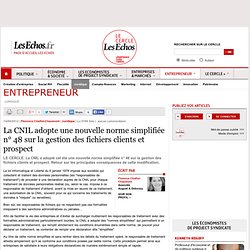
Bien sûr, les responsables de fichiers qui ne respectent pas ces formalités s'exposent à des sanctions administratives ou pénales… Au titre de cette norme simplifiée et sans rentrer dans les détails du traitement opéré, le responsable de traitement atteste simplement qu’il se conforme aux conditions posées par ladite norme. Cette procédure permet ainsi aux entreprises de satisfaire à leurs obligations déclaratives de manière extrêmement simple et rapide. 1) Mesures répondant aux attentes des professionnels Sécurité.
TF1 vs Youtube. M6 vs TV Replay. Pearltrees ToS. Intellectual Property. After decades of ever more draconian statutes and judicial decisions, our intellectual property system has veered far away from its original purpose.
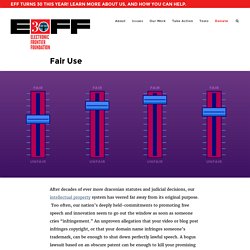
Too often, our nation’s deeply held-commitments to promoting free speech and innovation seem to go out the window as soon as someone cries “infringement.” An unproven allegation that your video or blog post infringes copyright, or that your domain name infringes someone’s trademark, can be enough to shut down perfectly lawful speech. A bogus lawsuit based on an obscure patent can be enough to kill your promising and innovative startup.
It doesn’t have to be this way. Ideally, intellectual property law—generally, copyright, patent, and trademark—is supposed to embody a balanced incentive system. Trademarks work a little differently—they are supposed to protect consumers by encouraging sellers of goods and services to stand by their brand, so consumers will know what they are buying. What does that veto look like? Fair use. Fair use is a limitation and exception to the exclusive right granted by copyright law to the author of a creative work.
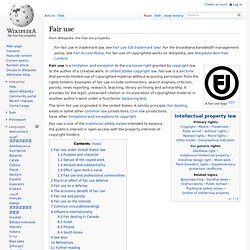
In United States copyright law, fair use is a doctrine that permits limited use of copyrighted material without acquiring permission from the rights holders. Examples of fair use include commentary, search engines, criticism, parody, news reporting, research, teaching, library archiving and scholarship. It provides for the legal, unlicensed citation or incorporation of copyrighted material in another author's work under a four-factor balancing test. Fair use is one of the traditional safety valves intended to balance the public's interest in open access with the property interests of copyright holders. Fair use under United States law[edit] The legal concept of "test copyright" was first ratified by the United Kingdom of Great Britain's Statute of Anne of 1709. Once these factors were codified as guidelines in 17 U.S.C. § 107, they were not rendered exclusive.
Fair Use. U.S.
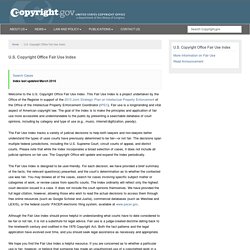
Copyright Office Fair Use Index Welcome to the U.S. Copyright Office Fair Use Index. This Fair Use Index is a project undertaken by the Office of the Register in support of the 2013 Joint Strategic Plan on Intellectual Property Enforcement of the Office of the Intellectual Property Enforcement Coordinator (IPEC). Fair use is a longstanding and vital aspect of American copyright law.
The Fair Use Index tracks a variety of judicial decisions to help both lawyers and non-lawyers better understand the types of uses courts have previously determined to be fair—or not fair. The Fair Use Index is designed to be user-friendly. Although the Fair Use Index should prove helpful in understanding what courts have to date considered to be fair or not fair, it is not a substitute for legal advice.
Copyright & Fair Use - Summaries of Fair Use Cases. Thumbnail. Implementation[edit] Displaying a significant part of the picture instead of the full frame can allow the use of a smaller thumbnail while maintaining recognizability.
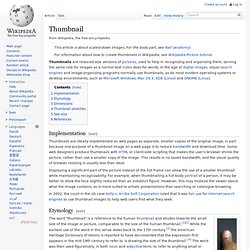
For example, when thumbnailing a full-body portrait of a person, it may be better to show the face slightly reduced than an indistinct figure. However, this may mislead the viewer about what the image contains, so is more suited to artistic presentations than searching or catalogue browsing. In 2002, the court in the US case Kelly v. Arriba Soft Corporation ruled that it was fair use for Internet search engines to use thumbnail images to help web users find what they seek.
News.me case study. Readability case study. Instapaper case study. Pulse case study. Zite case study. Flipboard case study. Does the content curation model encroach on copyright issues. Twitter Terms of Service. What are some ways to prevent and/or deal with legal issues that arise from actions of users on user generated content websites.